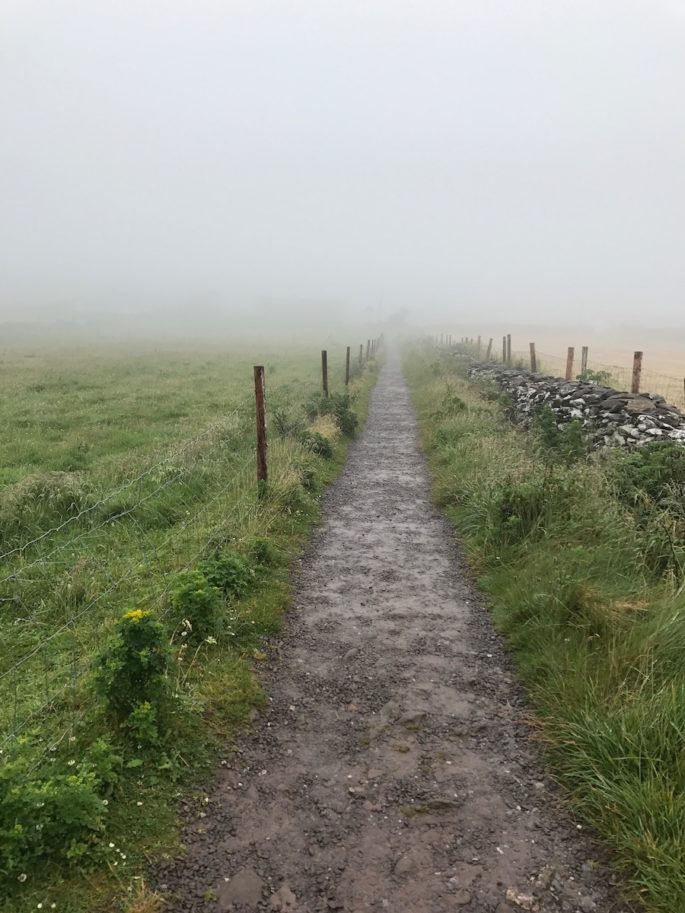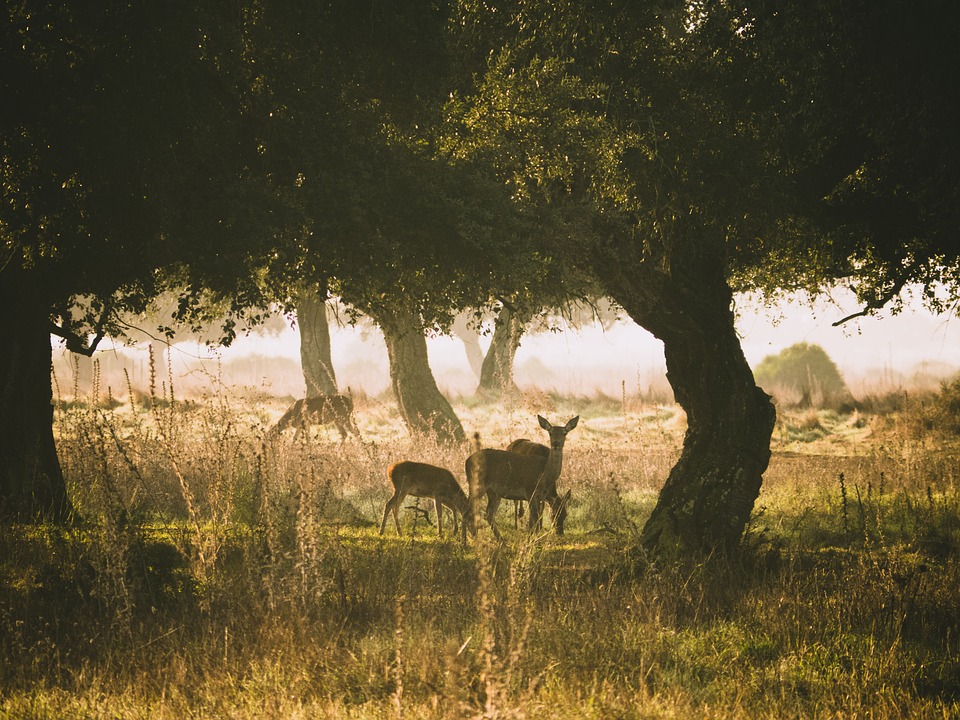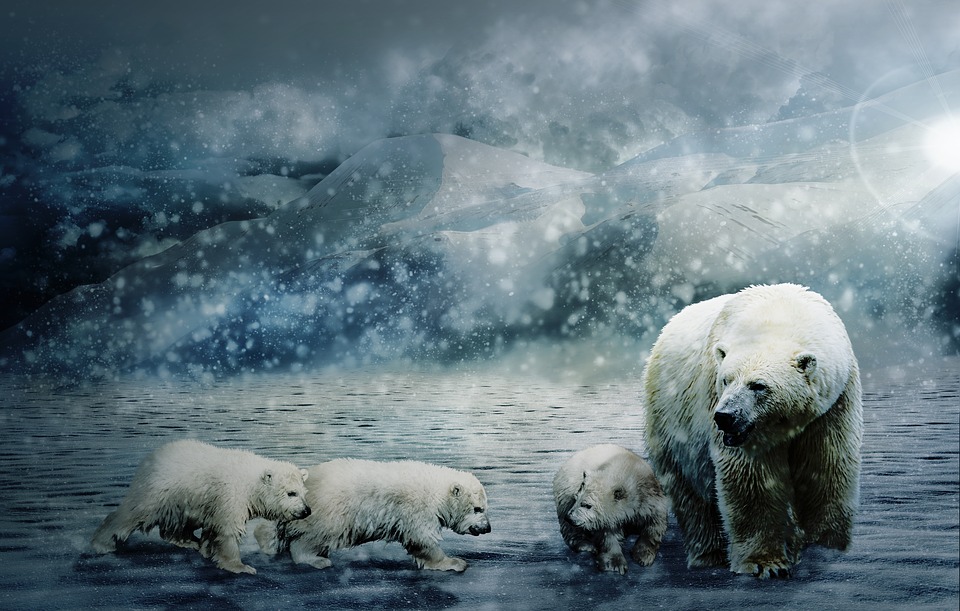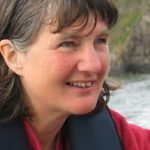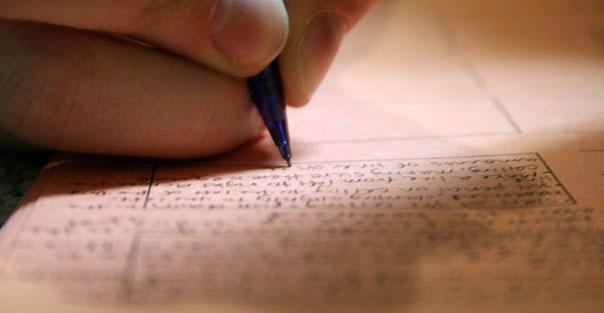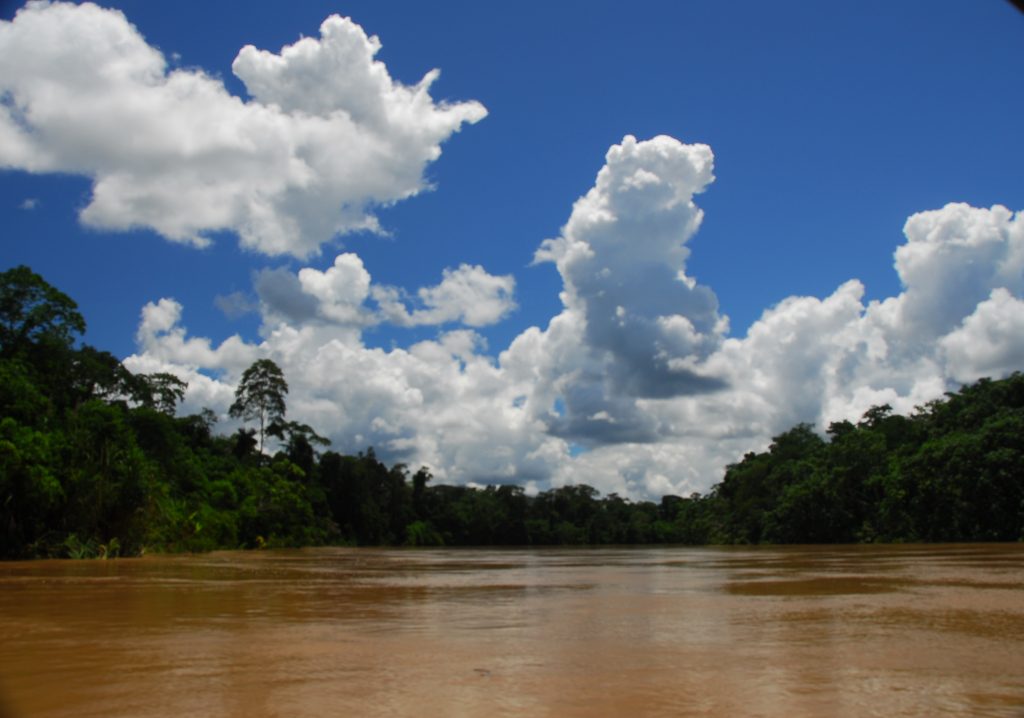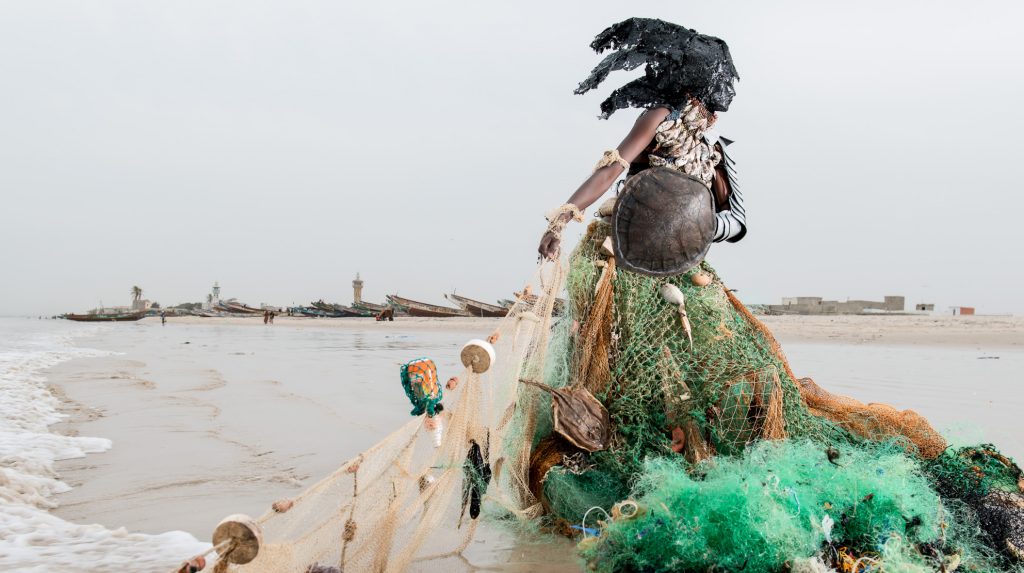The Lie of the Land | Conversation and Essay
This feature is possible through a collaboration with CCC19 – Climate Change and Consciousness: Our Legacy for the Earth, at the Findhorn Foundation, North Scotland, April 20-26, 2019. The event will feature some of the clearest and most passionate voices for the Earth ever gathered together in one place. Kosmos is an official hub for CCC19.
Conversation | Marie Goodwin and Margaret Elphinstone
Marie | I know you’ve participated in some of the Dark Mountain Project’s offerings. They are very oriented toward the expression of grief, loss, and emergence around what is happening to the biosphere, especially through story. We’ve also seen “story” as the centerpiece of “MeToo” and other such activist work. How do you think more mainstream environmental movements, like Extinction Rebellion, 350.org, etc., might employ story to make them more effective and ultimately break through the profound denial of most people on this planet to what is happening around us?
Margaret | We can’t do this without art. Unlike all other species, we’re driven to represent the world in images. Being able to conceive such images is wonderful—magical, even—because this is where transformations begin. But the minds that can imagine art sadly also use their ingenuity to destroy as well as to create. In this crisis to which we’ve brought ourselves, we can only change what is happening through transforming the way we imagine things. That happens through art. This is why I think stories and images are crucial if we’re to cope with our impending fate with kindness and dignity. The story may not actually be about our own survival, but it has to be about how we fit in. We need to find our way back to where we belong.
It’s fruitless to bludgeon people with terrifying statistics, even though the data is correct. Fear entrenches people more firmly in their denial. Denial leads to increased consumption, and yet more exploitation of other beings. Denial is about fear for one’s individual self. But, here and there, the story is beginning to change, especially among the young who will inherit the earth in whatever pitiable state we leave it to them. The symbols by which we lived are broken. They will use the shards to make something new.
Here’s a story: I have one day more to live. I am spending it in the place that matters to me most. I sit on the shore, watching how the sun catches the ripples on the water. There’s a flash of colour. Kingfisher! He darts ashore, vanishes among oak leaves. Reappears in sunlight. A flash of blue and red. Dips between ripples. Up and away. Gone. There have been so many moments. There was love, and a little understanding. Kingfisher will soon be back, but I’ll be gone.
The new stories cannot be about us.
Marie | You seem to really enjoy islands and island landscapes as places to set your stories. Sometimes the islands seem like characters in their own right. Some of these locations are rather close to your home in Scotland, but some of them are islands that are shrouded in mystery, like the Greenland colony from the Icelandic Sagas or mysterious places like the island of Hy Brasil. Can you talk about why you’ve made these landscapes such an integral part of your story-telling? What wisdom do island landscapes and lifeways have to offer to the landlocked among us?
Margaret | On an island, I’m surrounded by an element which is not my own. There is a magic about arriving by boat, and being somewhere which is so completely, definitively its own place. There is a different kind of magic about being on an island when the sea is too rough to cross. We’re on our own then, and no one can get to us. Sometimes I’ve lain on the cliff top when the whole Atlantic is breaking against the land below, and felt the shudder of each wave in the ground under me. Islands are safe, but exposed to sea and wind, sky and weather. In contrast, human life on an island is small-scale, but every individual is vitally important. That’s why proportion on a small island can feel so exactly right.
An island is somehow knowable. From its edges, I can look out on sea and sky in every direction. Although we are enclosed here, the wide spaces are infinite. I am always on the edge, looking out. At the same time, our boundaries are very clear; the place where we belong has clear boundaries and we know exactly where we are. Live there long enough, and I might really begin to understand the place.
Living on an island concentrates the mind wonderfully: I never go further than I can walk, and while I am here, this is where my thoughts are. An island, like the world.
Marie | In your essay here, The Lie of the Land, you’ve done something I’ve seen you do elsewhere in your books. You have this really beautiful way of weaving the land into your writing as if the landscape is a distinct character, an active participant in the story. Your human characters move through the land and are experiencing the world as a kind of sensuous, visceral “map” or a “territory.” I assume that is the way you also experience landscapes when you are walking? If you have such internal, visceral maps of place, where is your favorite and can you describe it for us?
Margaret | We have an instinct to be hefted—to belong where we are, to understand ourselves as part of that place. We can survive disruption with this instinct intact—just as, during a long life, we lose the people we loved first and learn to love others just as much. But what happens if this instinct is thwarted from the beginning? What happens if people grow up in separated enclosures, and are told that there is no living world out there, nothing to connect with? That’s what I call cruelty, and children cruelly treated learn how to be cruel.
The Lie of the Land is based on my own childhood. I say ‘based’ not because it’s fiction, but because layers of memory laid down over 60+ years are unreliable. But it’s about how I learned who I was and where I belonged, and that part is, I think, wholly reliable. Those particular Kentish fields disappeared long ago, and the wood where the oak tree grew is now an isolated island of green amid urban sprawl. I still walk through fields and woods nearly every day, just as I did back then, but in a different country. Every day, I learn a little more about my territory. I love maps, but this particular map is not in my head—I’m not making a mental image of it, as if I were looking down on it from above. I’m living it from the inside. I’ve known it long enough to observe changes: trees fall, paths shift, riverbanks change after every flood. The chanterelles have moved further under the trees, and the blackthorns have grown thicker. There is a particular path by tumbling waterfalls that leads down to the loch. In that particular piece of wood lies the heart of the matter, as far as I’m concerned. I did my best to describe what that meant in my first novel, published 30 years ago, but it eludes description, just as it eludes experience. I see it as what the wood is like when I am not in it. That, not myself, is the centre of the story.
Marie | How, and to what extent, do you think that such internal maps help shape our view of reality?
Margaret | No one can fully imagine the earth and all that’s in it. When I try to do so, I see the modern icon of our blue planet from space—beautiful, but the ultimate in the god-like view, observing from the outside. The only way to be right here, on the inside, is to belong on a human-sized bit of earth, and to live with it, so that you grow and change together. Our distant ancestors’ hunting lands extended as far as their feet could carry them or their eyes could see, and probably that’s the extent we’ve evolved to encompass. The god-like gifts of technology come at a price, and part of what we pay is a loss of proportion: the simple measurements of our own bodies, which tell us automatically how much space we’re supposed to take up. Our amazing ability to conceptualise is actually housed in quite a small body, and our real needs are simple. Unlike the other large apes, however, we need food for our dreams as well as our stomachs. But dreams don’t have to destroy everything that lies around us; we have made a terrible mistake about how to live our dreams. The earth could spare a bit of red ochre, a poisoned arrow, or a few magic mushrooms, if that helped make our fantasies come true. It can’t spare everything and everyone it’s got, which is what we’re demanding now.
Belonging to the land means knowing that this place is not about you. Part of being a predator with imagination is being aware that your presence changes everything. Deer and rabbits run, birds take flight, hedgehogs curl up, otters or frogs plop back into the water. The sound of our footsteps from underground must leave everyone down below cowering, and no wonder. We need to keep still and shut up. When I think of the people I know who are doing the least harm, they are mostly unassuming, often marginalised and disregarded individuals, living quiet lives in familiar places, not whizzing about. I want to learn to read their internal maps, because those are the routes I wish to follow.
Marie | In this time of converging crises, how can the joy of discovery, and deep connection to nature, guide us?
Margaret | No one wants to destroy the things they love, but it’s hard for us to stop being violent because we’ve grown up amidst carnage. All my life it’s been normal to see trees, hedgerows, marshlands, peatlands, shorelines bulldozed into oblivion, one habitat after another rendered uninhabitable to millions of living beings. It’s happening now, in this glen where I live, and its surrounding hills, while I sit here writing. I’m trying to write about life, and even as the words hit the page, they form an elegy. I don’t want elegy, I want celebration.
Coming alive hurts. The joy of discovery is also about the pain of realisation, and that’s why the walk to the loch doesn’t lead back through the gates of Eden. When I’ve hurt someone, it’s tough to listen to their reaction, but I don’t learn if I don’t listen. My first instinct is to defend myself (I don’t fly and I do recycle my plastic bottles) and to refuse to accept what the other person is saying (and anyway I didn’t ruin your life). If I can hear what I’ve done (yes, I’ve driven a diesel car and have probably eaten my way through a field of cattle). If I can forgive myself (in the language of my childhood: ‘pardon and deliver you from all your sins’), then maybe I can get on with the joy of discovery and the deep connection.
Like every one of us, I was born innocent, ready to feel that joy, and already wholly connected. No individual is to blame for what went wrong. No one can do their best now if they’re paralysed by guilt and regret.
The other beings on this planet aren’t paralysed in this way, so maybe we should regard them more closely as shining examples. They do what they were born to do (whether we always like what they do is our problem, not theirs). I don’t wish to encounter a polar bear, but I wish passionately that polar bears will be still be here when I am gone. Their survival as a species is a lot more important than mine as as one oldish woman.
This is what connection is: it is the realisation that the story is not all about me. Once I take myself away from the centre of the narrative—all those little loves, hopes, dreams, ambitions, neuroses, needs, guilt trips, and terrors that make up what I experience as ME—I am free to respond to what’s around me. It happens sometimes in a flash, like a kingfisher’s flight. I’m suddenly aware that everything is alive. It’s not ‘out there’ any more, and I’m not ‘in here’. It just is.
Essay | The Lie of the Land, by Margaret Elphinstone
That was the important question: where everything was. There were various ways of setting out: down the drive like a grown-up, or over the wall behind the chestnut trees, or through the gap in the fence beyond the compost heap. Through slow months and years, the unknown unfolded itself and became familiar. But every new way always led to more ways, still unexplored. Their secrets beckoned, and you had to follow. You had to find out.
Stinky Pond had newts in it, which laid their eggs in little blobs. If you put the eggs in a jar, they never hatched—not like frogs’ eggs. There were frog tadpoles every year at school. Blue mayflies skimmed over Stinky Pond with sun on their wings. Clouds of gnats buzzed over mud-coloured water where the pond got deep. If you lay on your stomach on the muddy bank, and put your face close to the water, you could see water boatmen skimming along the surface, and underneath, minnows darting in the shallows. The brook from the lower end of Stinky Pond meandered through cotton grass and bullrushes, and that was the best place for dragonflies. At the top end of Stinky Pond, there were hazels entwined with brambles and Old Man’s Beard. The Old Man’s Beard was so matted over the elders by the brook that you could climb up and lie in it. No one would ever see you there, but then there was never anyone to see anyway. People occasionally walked through the wood on the bridle path, and the path to the kissing gate, and the muddy track at the bottom of Stinky Pond. The people always talked, so you knew exactly where they were. If you lay flat on a branch of the Big Oak which hung over the bridle path, they would walk or ride below you and never guess you were there. Once, a man, unaware of your watching eyes, peed against the oak just beneath you. When he’d gone, you slid down fast and ran away, strangely ashamed although you’d done nothing wrong.
The Big Oak had great sideways branches, too vast to twine your legs around, on which you could lie flat. If you rubbed your bare feet hard against the knobbly oak-bark, it gave you a tingly feeling which went right up your back. The oak branches were quite far apart; you had to grow tall enough to do the big gap. You stretched up as hard as you could, but you couldn’t quite reach. “Maybe when I’m nine,” you thought. But your will grew faster than your height. That same summer, you managed to get your arms around the branch above and grip your hands tight together over it. It was scary to swing your legs free, so far off the ground, but you somehow got them round the branch and hauled yourself over, like getting on a tall horse. You sat there, triumphant, and thought distinctly in words, “I said when I was nine. I’ve done it, and I’m still only seven.” From the big gap, you could get almost to the top. You were right inside the leaves so you could hear them rustling in a breeze you couldn’t feel, but you could never touch them. They grew far out from the trunk, and up there the branches got too thin to wriggle along easily.
If you went a little further along the bridle path past the Big Oak, a grassy path dropped down to the right, skirting one of Holbrook’s fields. It followed a hawthorn hedge with twisted shiny roots sticking out where the soil had washed into the brook. At the bottom was a hollow tree. There were two ways in. Either you crawled underneath into a leafy hideout smelling of owls, or you swarmed up the smooth trunk and dropped in from the top. The underneath way got tighter as time went by, and the top way got easier. If you crossed the bottom of Holbrook’s field, you came to a muddy path which went round two sides of Stinky Pond. Horses’ hooves had churned it into chocolate icing by the gate.
The gate was an ordinary five-barred gate, set in a brambly hedge. Brown cows with white bellies grazed in the field beyond. You never climbed the gate, because there was so much to do at Stinky Pond. But that gate was important. Slowly you began to see…
The way into the wood that grown-ups used was to follow the road downhill, where it lost its tarmac and became white and flinty and somehow very old. In summer, the chicory and Jack-by-the-Hedge along the verges were white with dust. When you were sent out with your basket to find food for the rabbits, the road was, therefore, a bad place to go. The other side of the hedge had no dust, and there you picked dandelions, clover, vetch, and rarer delicacies (but never bryony or nightshade) until your basket was full. But if you were going to the wood, the track ended at the kissing gate. There was a house with a high wall by the track, so that the kissing gate was the only way into the wood. Grown-ups lived at the house, and you’d once been to the door with your mother, to deliver something. You’d cast your eyes around the garden as much as you could, but the grown-ups were of no interest, and you never explored it.
The other way to set out from your own garden was to go through the gap in the fence behind the sycamore tree, and on to the Manor House Drive. The grown-up way into the Manor House was through the big gates just beyond your garden. The gates had brick pillars on each side, and a white stone ball on top of each one. You could climb the wrought-iron gate by the hinges, and step from there on to the top of the pillar, where you could sit on top of a white stone ball, like sitting on the very North Pole of the round world. You kept your ears open though, in case anyone were to come down the drive, but no one ever did. The gap in the fence was a more secret way. The Manor House Drive was covered with flat groundsel and stunted dandelions, and only had two lines of bare wheel tracks. There was a green bump running between the wheel tracks, which felt quite warm in the sun if your feet were bare.
Manor House Drive turned a corner into rhododendrons that were almost a tunnel. From here you avoided the open drive, and crept through pale-brown rhododendron stems under the canopy of dark-green leaves. It was so sheltered that even when it rained you didn’t get wet. You just heard the drops pattering very loud on the hard leaves just above you. It was a long den-tunnel, safe in this forbidden territory. But the end brought you too close to the house for comfort, not that anyone was ever there, so you peeled off to the left, wriggling under the leaves and into the meadow that had once been the front lawn. It was only safe to go this way in summer. In winter, the grass went flat and gave no shelter. But in summer, the grass was waist-high and flecked with cuckoo spit, not that you ever stood up here, because huge sash-windows looked out over the lawn, and someone might be watching. Instead, you wriggled across on your stomach, leaving your own snail-trail (only not sticky), which was invisible to anyone unless they came right up close. Sometimes you squashed a slug, which left yellow marks on your aertex shirt. But if you lay on your back in the middle of the Secret Lawn, there was blue sky above you, or sailing clouds, and purple grass-heads and red poppies quivering just over your head. And once you’d wriggled right across, you were in the Further Wood, where you could stand up again, hidden among sycamore saplings, all growing through leggy garden shrubs whose names you didn’t know.
The shrubbery had paths where dog roses reached out from behind the bushes and scratched your bare arms and legs. You squeezed past, sometimes crawling underneath the prickly stems. Even in the summer holidays, the blackberries here were not much good. The witches spat on them early, while the ones in the fields were still firm and ripe long after school had started. Beyond the shrubbery, in the middle of a grassy space, stood the Roman Remains. On the day you discovered them, two Red Admirals were mating in the shimmering air over the ruins. That was a fine omen: Red Admirals were your favourite butterfly. When you were all painting butterflies at school, most of the others played safe and chose Cabbage Whites or Common Blues. But you picked the Red Admiral, and spent several art lessons trying to get the soft, hairy red-brown background, the valiant orange blotchy stripes, the white wing-spots that looked like someone just shook the brush at random, only actually the exact spot mattered. By the time you’d finished, the others had long moved on to some other project, but the gorgeous configuration of the Red Admiral was now yours for life.
So the Roman Remains were also the Red Admiral Mating Place, but the remains themselves were of more than passing interest. The structure had been a wooden hut with slatted windows. Under it was an iron circle set in the ground, upon which the hut appeared to be balanced. Peering underneath, you made out a sort of rusty wheel, which must mean the whole hut had once moved round. Hard as you pushed, there was no way you could move it now. Too many centuries had passed, but it was clever, like aqueducts and central heating. You had once seen a Roman villa, so you knew about these things. Another time you brought a trowel and tried to dig for coins (there had been coins at the villa), but the ground was hard and stony under the matted grass.
A little way downhill from the Roman Remains, you discovered the Roman Baths. They had high concrete walls and had once been tiled, just like the tiles at the swimming baths. You climbed down at the shallow end, and walked over broken concrete where nettles and willow herb had pushed through. Bits of concrete had fallen off the walls at the deep end. It was sweaty-hot down here, and too shut in, but whether you liked it or not, you had to go and touch the end wall. It was there, in the hazy heat in the far corner, that the adder basked on a concrete shard. You stopped, staring, a safe six feet away. The adder hadn’t seen you, didn’t move. Slowly you took a step closer. And another. If it moved you could run. The dark diamonds along its back were like beads on a string, and you could see the V-mark on its neck which proved it wasn’t a grass snake. One more cautious step. The little snake flashed into the nettles. Gone. You never saw it again. Only, every time you came back, there was the big shard of concrete, forever pregnant with absent adder.
Beyond the Roman Baths, a broken stile led into a field that sloped steeply downhill. There were usually brown cows with white fronts in the field. Holbrook’s cows were brown and white, whereas most people’s were black and white. Somehow this was significant, but it would take time for you to think it out. Meanwhile, there was a diversion, which kept you from the Roman Remains for quite a chunk of time.
You’d once had a friend called Mary, who’d lived in the village, but then her family moved to Australia, travelling on a Ten Pound Ticket which was a sort of boat, perhaps something like a Tramp Steamer. Since she’d gone, you’d had everywhere to yourself. The house next door had always been empty, because it was Bombdamaged. You were familiar with Bombsites, which were piles of rubble among rows of houses, pink and misty in summer with willowherb. Sometimes the walls next to Bombsites had the sides of rooms on them, like open dolls’ houses, with wallpaper, shelves, and fireplaces. Very few streets didn’t have Bombsites. The Bombdamaged House wasn’t rubble, it was redbricked and tall, with a big crack in one gable. Then, one day, John Alan was living in it with his mother and little sister. He said they were going to Be-re-housed. You didn’t know where that was but didn’t like to ask. When he asked you over, you climbed the fence, and together you explored this other garden. It was dark with laurels, except for an open lawn with a sundial. You tried to read the sundial but there was too much lichen. At the far end of the lawn, you and John Alan found the air raid shelter. You wouldn’t have known what it was, but John Alan knew. It had a corrugated iron roof with turf over it. The door hung open, revealing a black-dark space. “Wish we had a torch,” said John Alan.
Back over the fence, in at the back door, you took the torch off its hook, part of you wishing you’d never mentioned that you could find one. Over the fence again, across the lawn, down to where John Alan waited, above that gaping hole in the ground, like a tomb. Perhaps there were dead bodies down there, or, worse still, skeletons. Before she went to Australia, Mary had told you terrifying stories about skeletons. Her stories had put you off walking down the garden after dark to feed the rabbits. That didn’t last long because you realised you’d never see the stars or hear the owls any more if you didn’t go out at night. You’d decided you would never love anything again that had a skeleton. But that had only really left worms and caterpillars, so you’d thought better of it, and mostly forgotten. But, now and again, Mary’s skeletons came back into your mind, like now.
“You go first,” said John Alan, “As you’ve got the torch.”
To argue would be to lose face, so you went first. Water leaked into your sandals, cold against your feet like clammy fingers. You shone the torch round the corrugated walls. “There’s nothing here.” The door darkened and John Alan came down the steps and stood beside you. You shone the torch again. A bench against the wall. A shelf, with white things. Your stomach clenched. But it was only plates. A pile of plates and some white mugs. That was all.
You never went into the air raid shelter again. Soon after, John Alan moved away to Berehoused. Occasionally you went into the laurel-infested garden of the Bombdamaged house, until one day workmen arrived, and there was scaffolding and much banging. Not long after that, the Bombdamaged house was gone, turned into a Bombsite with white rubble. Without John Alan, the garden always seemed strangely empty, and you stopped going that way.
The Roman Remains and the Roman Baths were as deserted as ever. It seemed to take less time to get to them than it used to do. In winter, one could go round by the trees, when the lawn was too bare to cross. When it snowed, there were tyre marks in the drive, and once, quite near the house, you found grown-up footprints. The lawn had been criss-crossed by two-and-one rabbit prints, and many different birds, ranging in size: pheasant, blackbird, wren. There were paw marks near the Roman Remains. They had claw marks, so not a cat. Must be a fox. Or a wolf perhaps—no, better not start pretending that.
The snow went away again, but now there was water in the Roman Baths, covering the Adder Stone. You skirted the baths, and climbed up on to the stile. The field was thick mud round a hayrack at the bottom, but there were no brown and white cows to be seen. Always brown and white in this field… Holbrook’s cows were brown and white, and most other people’s were white with black blotches. Something tugged at the edges of your mind. You stood at the top of the stile looking down into the field. There was another field below, and away at the distance, at the hedge on the far boundary, a five-barred gate. There was something about that distant gate which you seemed to recognise.
At last the time came when you had to act. The house martins had gone, and small conkers were beginning to drop in the Spur Road. When you fed the rabbits after tea, you could see the evening star through the thinning light. On a weekend morning, you told your mother, “I may be a little longer than usual,” in case she worried. Causing grown-ups to worry was one of the few things you must never do.
You went round by the wrought-iron gates; the gap in the fence had become a bit of a squeeze lately. Yellow birch leaves scuttered along the wheel tracks of the silent Manor House Drive. You ducked under the rhododendrons and circled the far end of the lawn, keeping a wary eye on the big sash windows. They glinted in the sun so you couldn’t see if there was anyone at the window. A cloud sailed over. The windows darkened. You suddenly saw through the windows, quite clearly, into the rooms inside. Someone was standing at the right hand window. Her hair was white. Her hand was at the curtain, holding it back. At once, by long instinct, you stepped back into the shadow of the rhododendrons. Parting the leaves cautiously, you peered across the lawn. The sun came out again, and the windows gleamed back at you, saying nothing.
You took an extra wide berth away from the lawn, across to the Roman Remains. They were looking more ruined than before. Some of the roof had come away in the last gale. You looked at them, troubled by the faintest shadow of a doubt. There was no question about it, some of the wood was rotten. White fungi grew along the cracks. Perhaps even the wheel was getting rustier. No time to think about that now, you needed to get on. You passed the Roman Baths, stopping just long enough to show a vestige of respect as you looked down on the Adder Stone. Up on to the stile, and there was the five-barred gate, clearly visible two fields below.
There was a reason why you’d never gone into the field. You knew Holbrook’s cows by sight, but you were not acquainted with them. Holbrook’s cows had with them a large brown bull. You had walked through Holbrook’s fields often enough with your mother. Your mother said bulls are quite happy as long as they have their cows with them. The important thing was to avoid the cows with calves. Or worse still, without their calves. You looked round cautiously. There were many cow pats, some quite fresh, but no cows in sight. All at once, you dropped down off the stile and ran down the field, keeping close to the hedge just in case. An open gate came into sight, down in a dip so you hadn’t seen it from above. There were hoofmarks in the mud all round it, but no sign of the cows. You looked through the opening. The field seemed empty, but there were ridges and hummocks so you couldn’t be sure of all of it. Between you and the five-barred gate, the land was quite open. It would take ages to go round by the hedge. You made up your mind, and ran like a hare at harvest, straight down the open field until you reached the gate. The somehow familiar gate.
In no time you were astride it, remembering to climb by the hinge end. And there…
There was the path round Stinky Pond, churned as ever with the prints of horses’ hooves. There, behind a grey screen of hazel wands, was Stinky Pond itself, brown and sleepy in the afternoon sun, with its gnats swarming over it. There it was, smelling its own particular smell of wet mud and rotting leaves.
The rush of joy you felt, perched there at the top of the gate, came flooding out of an overwhelming sense of discovery. It was the joining of the dots, like a puzzle. You saw it for certain now, this thing you’d kind of known for ages. You could leave the garden in two quite opposite directions, two quite unconnected forays into your particular, solitary hunting grounds, and you could circle around, and arrive in the same place. Everything that mattered—woods, fields, trees, hedges, brooks, ponds, hillocks—was not in lines radiating out from where you just happened to start. These things had circles and shapes of their own, a secret network, and you were part of it. Everything joined up.
You couldn’t go on at once. You climbed up into the hammock of Old Man’s Beard, in its fluffy glory now, and lay there, thinking. What was happening inside your head was a sort of map. Not that there was any map of here, of course, because this was just home. Maps belonged to the faraway hills, and were brought out once a year by your father for taking on holiday. Anyway, they were only made of paper, and this thing that you’d discovered—this new way of seeing unlike anything that had gone before—this was real.
You climbed down the Old Man’s Beard stems at last and walked slowly back by the other way. By the hollow tree, without stopping to go into it for once, up by the hawthorn hedge through Holbrook’s field. On to the bridle path, under the Big Oak, without climbing it for once, down the path to the kissing gate, and so out of the wood.
You came through the kissing gate, blinking in the low sun. There was a policeman in a helmet there, pushing a black bike. He asked you your name. You told him.
“Your mother’s looking for you. She’s worried sick. Do you know what time it is? Where have you been?”
So that was the price you paid, but it hardly seemed to matter. As for where you had been, you tried to explain, but there were not enough words, or if there were you didn’t know them. All the same, wherever it was you’d been, you knew you had to go back there, again and again and again.
The years sweep past you. You’re standing on a snowy summit. All around you lie ridge upon ridge of shining hills. You stand there, slowly turning full circle, ignoring the icy wind. You’re working out the mountains, how they connect, seeing how their spines meet and separate, how the glens divide them, how the rocks change, how there are watersheds, rivers, and the marks of ancient ice. How further off there is the sea, and islands whose shapes echo the mountain ranges. How there are tides and currents, firths, skerries, and stacks. How you have always to watch and learn and see how it all joins up. How you will never get to the end because there is no end to finding out. How this is what it is to be alive in your own country, and always to be just getting the lie of the land.
Speaking to the Animals about the Hunt | Margaret Elphinstone | TEDxFindhornSalon



